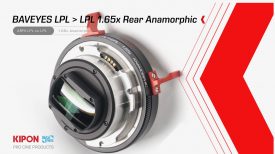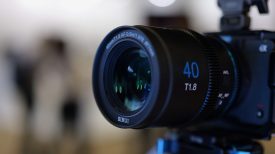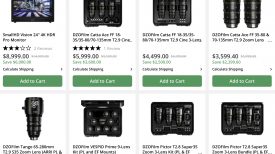
In the past, owning a high output fresnel HMI light was an expensive proposition. For a lot of owner/operators the high price point made them a rental only item. Over the last few years LED technology has come a long way and compared to tungsten fresnels, the newest generation of LED fresnels are capable of achieving the same levels of brightness, but with less than a third of the power consumption. The reduced electricity usage equates to lower running costs as the fixtures can be run from a standard mains power source. In comparison to tungsten and HMI lights, LED fixtures have almost zero maintenance costs as you don’t need to buy new bulbs and their LED light engines are rated to last about 200 times longer than tungsten lamps. As I just mentioned the biggest benefit is that you can run these lights off standard mains power supplies which was all but impossible to do for most large output HMI fresnel fixtures.
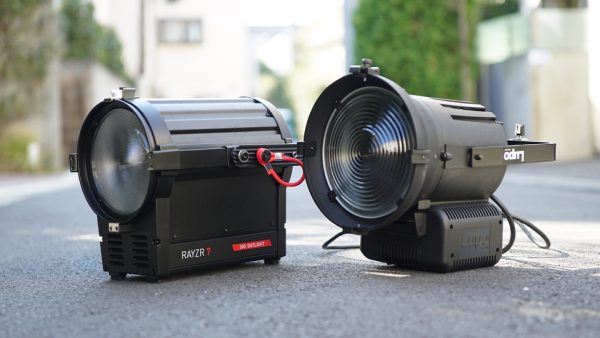
There are now several affordable high output LED fresnel lights available. Two of these are Rayzr 7 300 Daylight and the Lupo DayLed 2000 Daylight. Both lights offer similar functionality and make for a good owner/operator solution when you compare them against much more expensive LED fresnel lights such as the Arri L10-C and L7-C.
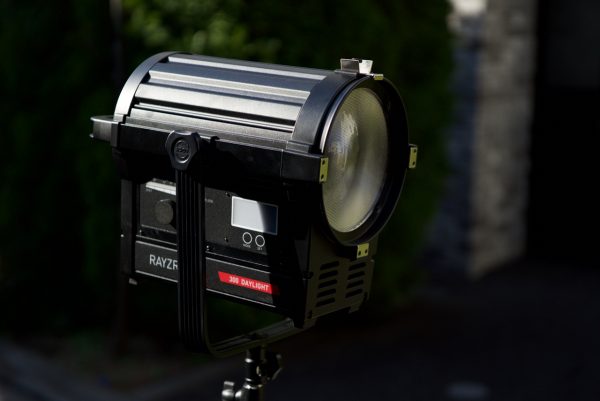
If you haven’t heard of Rayzr 7 they are a Dutch company, but the lights are made in China. They specialise in making LED fresnel lights and there are currently four different models available: 200 Daylight, 200BM Bi-Colour, 300 Daylight, and 300B Bi-Colour. For this review I will be concentrating on the 300 Daylight which is a 5600k fixture that draws 331W nominal and 352W maximum of power.
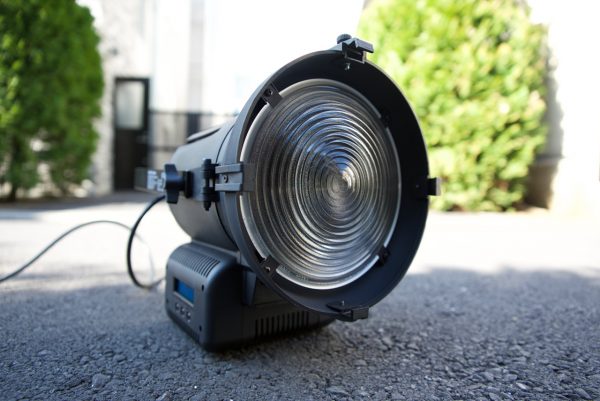
While Rayzr 7 is a relatively new company, Lupo have been around since 1932 and all their lights are made in Italy. Today they make a variety of LED lighting solutions including the DayLed 200 Daylight which draws 220W. Their DayLed 650 and 1000 lights have been very popular with broadcasters around the World.
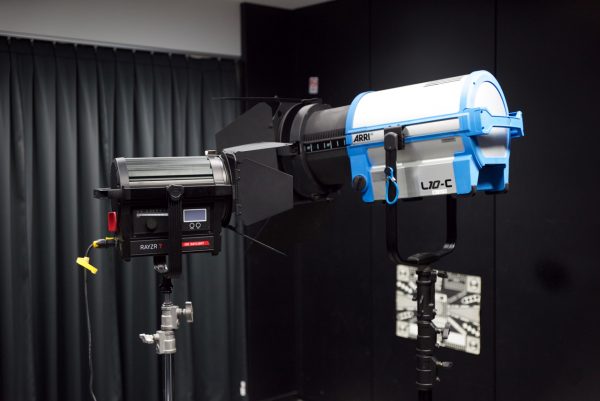
So lets have a look at both lights and see how they compare against each other. We will also compare the Rayzr 7 against the very good Arri L10-C, and the Lupo DayLed 2000 against a traditional Arri 2K fresnel.
Rayzr 7 300 Daylight
The 300 Daylight is the company’s largest and most powerful fixture. It weighs in at a hefty 6.4kg (14.1lb), and while this may sound like a lot, if you compare it to the Arri L10-C (19.7kg) it is relatively light. Rayzr 7 claim that despite the fact that the 300 Daylight is lighter than most other professional fresnels, it still features a strong and durable housing.
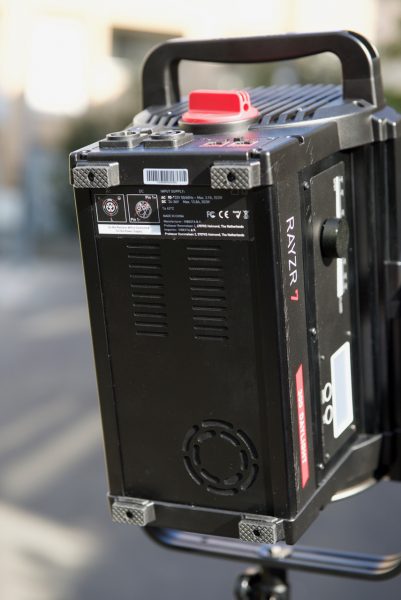
I found that there are parts of the 300 Daylight that are well made and others that seem to be a little on the fragile side. The yolk frame, carry handle and outer casing of the light all feel nice and solid. However, the side panels on the light and the plate that is on the bottom feel a little flimsy and look to have been made out of a lighter material. This has obviously been done as a compromise to keep the weight of the light down.
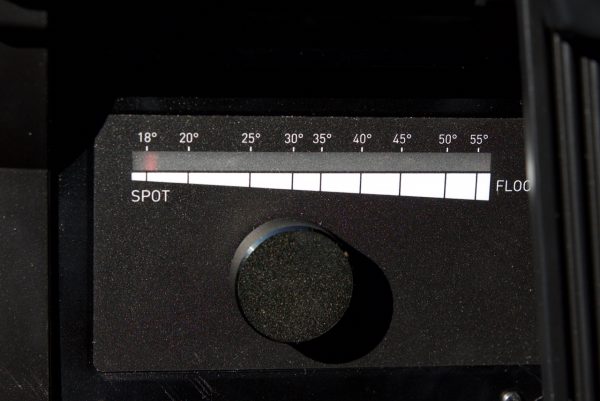
The dial on the side of the light that is used to control the level of brightness feels quite fragile, and I would be slightly concerned as to how this would stand up over time to the rigours of field use. To be fair though, if you are an owner/operator it will probably be fine, but I could see this potentially being a problem if the light was in a rental house.
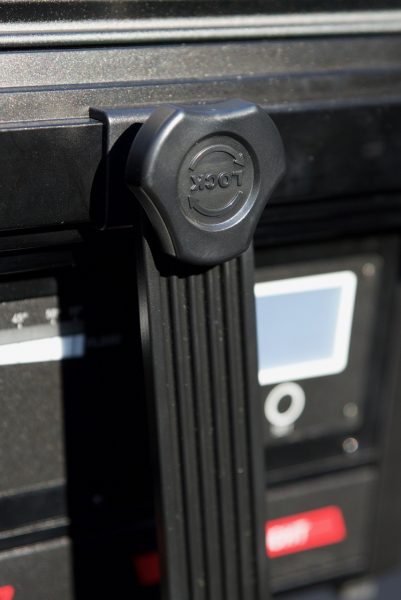
The tightening lock on the yolk frame does a reasonable job, but I still found I could move the light even when it was fully tightened up. This is probably due to the fact that the light only has one tightening lock and on the other side of the yolk frame it uses a large fixed screw. It’s just a personal opinion, but I prefer lights that have tightening locks on both sides of the yolk frame.
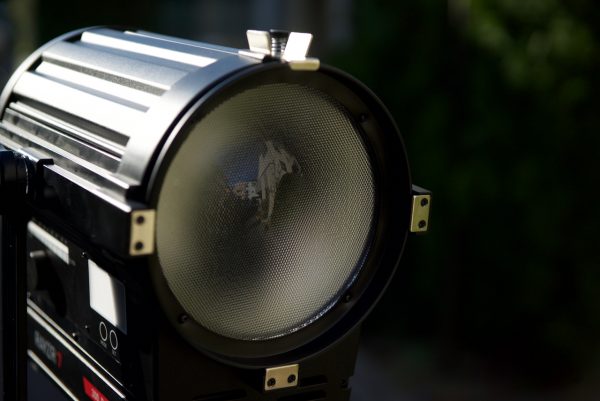
The front lens element is made out of plastic and it doesn’t seem to be very robust compared to most other fresnel lights. The other small thing that I did find is that the power cord that is supplied with the light is not particularly long. If you had the light on a stand above about 2 meters (6.56ft) the cord wouldn’t reach the ground. The on/off power switch is also located on the light and not on the power cord, so if you have the light up high you can’t reach it to turn it on and off. While this may not be a huge problem, it is definitely something to keep in mind.
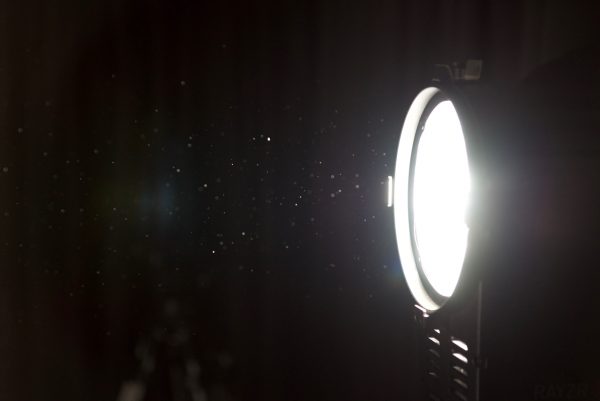
Quite a few HMI fresnel lights and some of the newer LED variants can take a considerable amount of time to power up. The nice thing with the Rayzr 7 is that it turns on almost instantly so you can use it straight away.
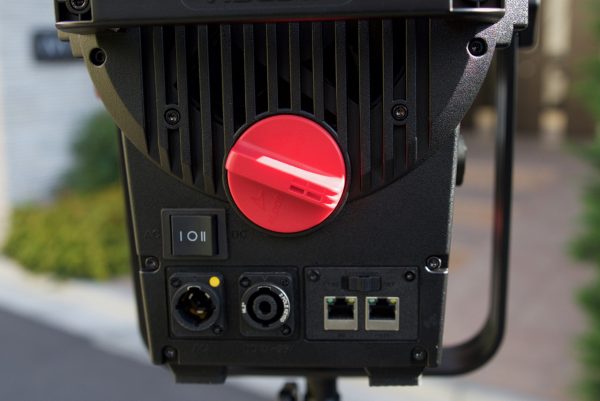
Operation-wise the light is fairly straight forward to use. There is a simple on/off switch, a large red dial that is used to spot or flood the light from 18° to 55°, and a knob on the side of the light that is used to increase/decrease the brightness. A large illuminated LED panel on the side of the light is easy to see and displays the brightness level which can be adjusted in 0.1% increments. The light can dim all the way down to 0.1% which is very impressive. The only slight drawback of offering such finite control is that it takes considerable time to go from 0.1% up to 100%. There is however another mode you can enter by pressing the set button, which lets you go up in 4% increments.
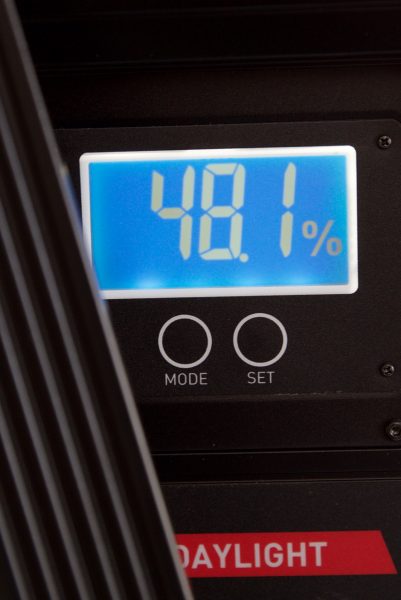
Another nice feature is that the light remembers the output level you last had it on when you turned it off. This is handy if you turn the light off and break for lunch and then come back and turn it back on. Even if you move the brightness knob around (as long as the light is off) it will come back on at the same exact level you left it at.
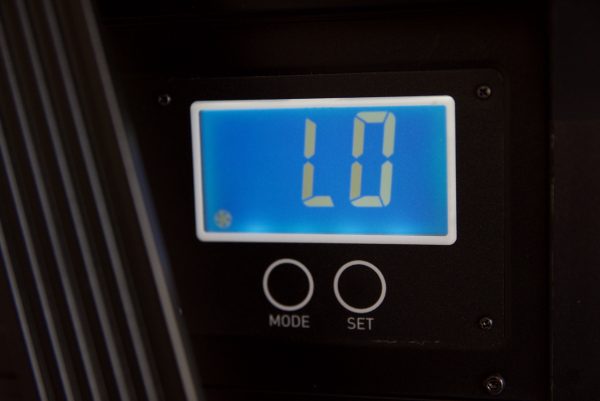
There is a mode button that you can press that takes you between the output setting and the fan speed. The fan can be set at either High or Low, depending on your shooting requirements. To my ear I could not really tell any noticeable difference in the noise when the fan was set on high or low. The noise it produces is very minimal and I doubt it would be a problem in the majority of shooting scenarios. The light also doesn’t generate much noticeable heat, which was a big problem when using traditional HMI fresnel fixtures that didn’t employ LED technology.

Another nice feature of the light is that it has a spot-to-flood beam angle indicator on the same side as the control panel. This way you can see exactly what beam angle the light is set at at all times. This is handy if you are running two or more of the same light and you want the beam angles to match exactly.
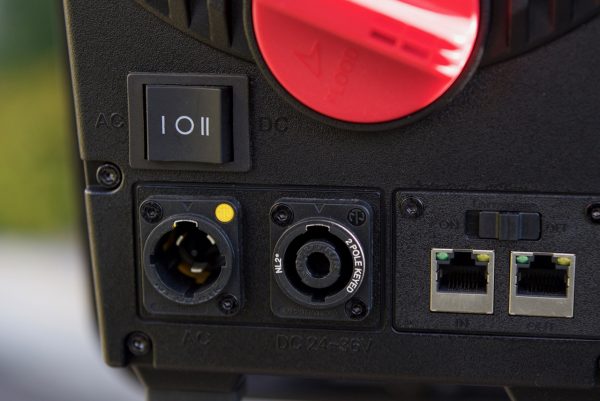
The light has an AC input of either 90-132V or 180-264V 50/60Hz, but this is factory preconfigured depending on where you purchase the light from. The 300 Daylight must be configured by an internal switch to choose between 90-132V or 180-264V. It can be changed by users with some mechanical skill — the setting itself is really just a switch so nothing complicated — but just opening the housing to get there needs some skill. If you don’t like the sound of that Rayzr 7 are also happy to make the switch for users. If you plan on travelling around the world with your light this is something you need to be aware of. There is also a 24-36V DC input if you want to use it remotely without mains power by running it off a compatible DC battery solution, as well as DMX in/out ports on the back.
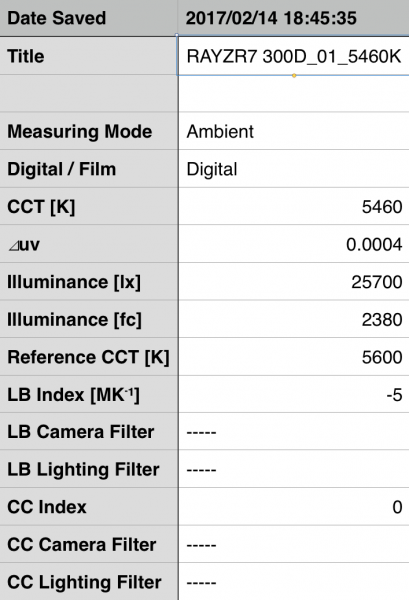
To test the light’s photometrics I used a Sekonic C-700 placed at a distance of 1 meter (3.28ft) in a controlled environment. This is exactly the same procedure I use for testing all lights that have been reviewed on Newsshooter. The 300 Daylight when set in its full flood position (55°) recorded a reading of 25700lx at a distance of 1 meter. It also recorded a kelvin temperature reading of 5460K and a ⊿uv of 0.0004. These results were all pretty good and tell me that the light is able to recreate a daylight 5600K source reasonably accurately.
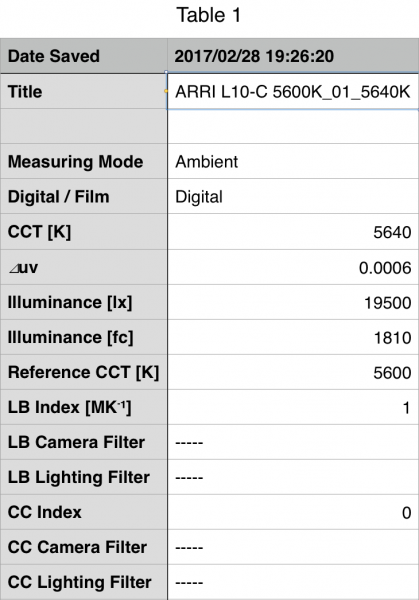
As a comparison here are the readings taken from the Arri L10-C when set at 5600K at the same distance. Please note that the L10-C is a 2800-10000K adjustable HMI fresnel with full – green to full + green control. As you can see the Arri had less output than the Rayzr7, but you need to remember that the Rayzr7 is a daylight only fixture and the Arri is not. Even still, it was interesting to see just how powerful the Rayzr7’s output was considering its weight and power draw.
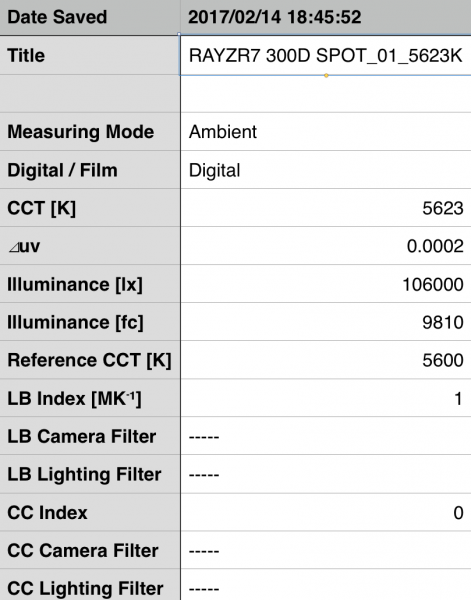
I then tested the light again in its full spot position (18°) and above you can see the output results. At a distance of 1 meter the light recorded 106000lx and a kelvin temperature of 5623K. The ⊿uv reading was 0.0002. The light is certainly capable of producing an extremely bright source when spotted up given its size. What was also nice to see is that the light was very colour temperature accurate in the spot position, and was able to replicate a 5600K source almost identically.
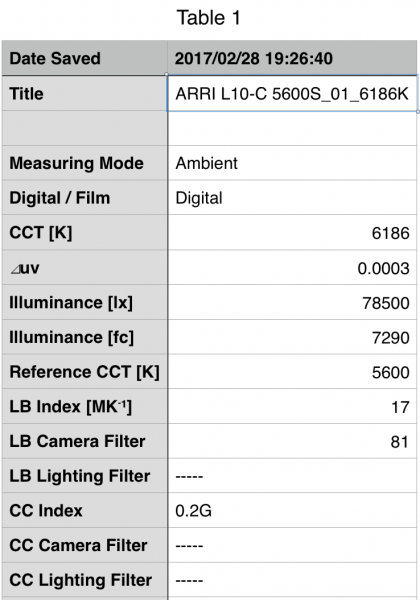
As a comparison here are the results I got when testing the Arri L10-C in its fully spotted up position. Again the Rayzr7 had a more powerful output than the Arri.
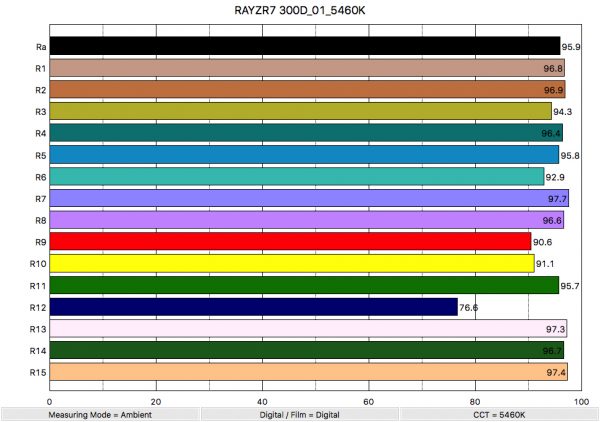
Above you can see the lights colour rendering scores when it was set in the flood position. The light recorded an average CRI (R1-R8) of 95.9 and an extended CRI (R1-R15) of 94.1. For the all important scores for replicating accurate skin tones, it recorded 90.6 for R9 (red), 97.3 for R13 (closest to caucasian skin tones), and 97.4 for R15 (closest to asian skin tones). These results were excellent for such a large source LED light and tell me that the 300 Daylight is very colour accurate. When tested in the fully spotted position the colour rendering scores were almost identical.
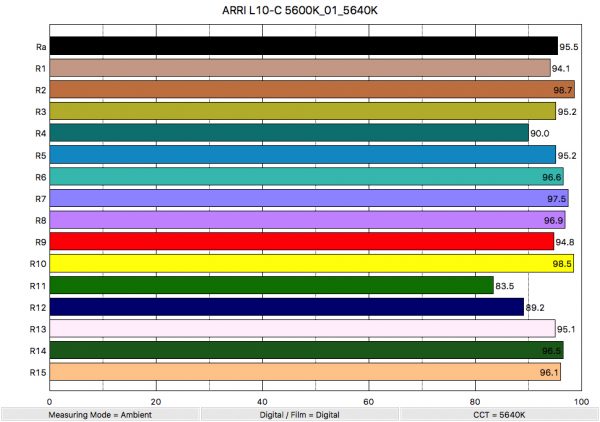
In comparison here are the results obtained by the Arri L10-C at the same distance in its flood position. As you can see both the Arri and the Rayzr7 have very similar colour rendering scores. The L10-C had a average CRI (R1-R8) of 95.5 and an extended CRI (R1-R15) of 94.5. For replicating accurate skin tones, it recorded 94.8 for R9 (red), 95.1 for R13 (closest to caucasian skin tones), and 96.1 for R15 (closest to asian skin tones).
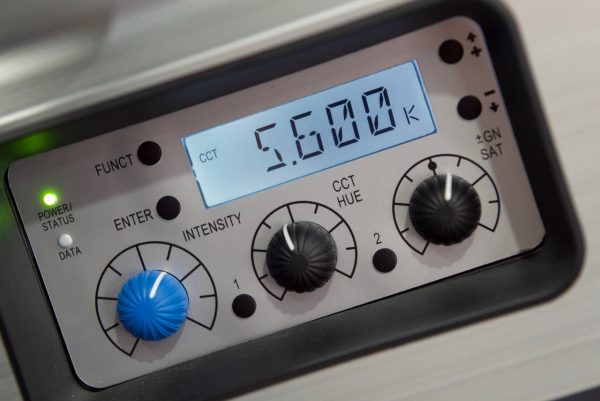
What is amazing is that the Arri, with its 2800-10000k colour range, was able to better the extended CRI colour rendering scores of a 5600K-only fixture. The L10-C also has the added advantage of being able to dial in or subtract green which makes it very easy to match any other lighting source you are using.
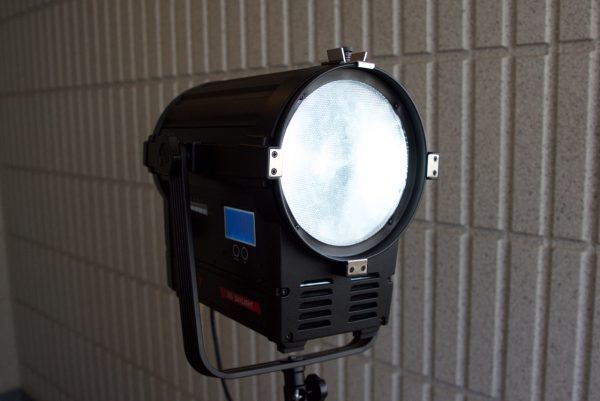
According to the company, unlike other fresnel lights the light distribution of the Rayzr 7 is even and homogenous without circular brightness differences or hotspots. Some fresnel lenses exhibit broken edges because of their design. This can cause colour fringing. Rayzr 7 use their own fresnel lens design which consists of very fine circles, which according to the company eliminates colour fringing and only “clean” white light is thrown forward.
To test out the claims of the light having an even and homogenous light distribution without circular brightness differences or hotspots I pitted it against the much more expensive and feature packed Arri L10-C. Above you can see a video where both the Rayzr7 and Arri L10-C are positioned at the same distance from the wall. I took measurements at distances moving away from where the center of each light was aimed. As you can see the Arri does a lot better job of maintaining an even and more pleasing light fall off than that of the Rayzr7. I did however find that the Arri had more colour fringing out towards the edges when the light was spotted up. It does seem that Rayzr 7’s claim that their unique fresnel lens design helps eliminate colour fringing is pretty accurate. Although it was still present, it was well contained.
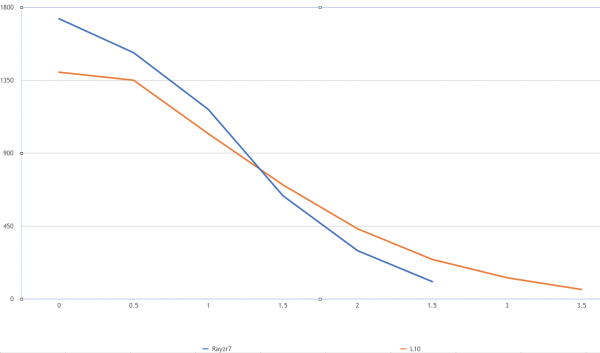
Above you can see a graph that shows how each lights brightness falls off when you move further away from its center point. As you can see the Arri has a much more linear fall off of light as it moves away from the center. The Rayzr7 falls off much more dramatically and this is very apparent when you compare both lights side by side. This may well be because of the differences in the sizes of both lights and/or the different fresnel lens designs.
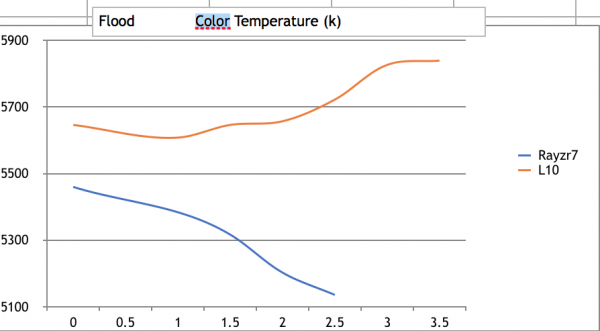
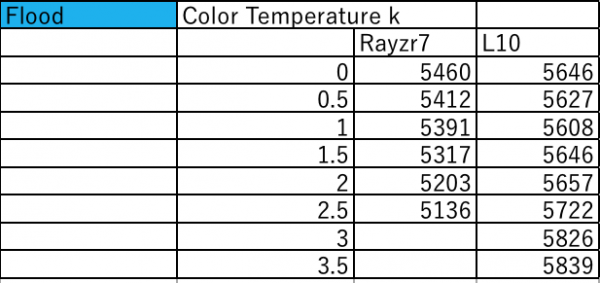
I also wanted to test if both lights kelvin temperature altered much, the further the light source spread out. As you can see from the above graphs when both lights were fully flooded, the Arri was able to keep a more consisent colour temperature even up to 3.5 meters away from the center of its beam source. By 2.5 meters the Rayzr 7’s kelvin temperature had already dropped down to 5136K. What is interesting to note is that the Arri’s kelvin temperature got slightly warmer, while the Rayzr’s 7 got a lot colder. Both lights kept very consisstent colour rendering scores even out to 3.5 meters.
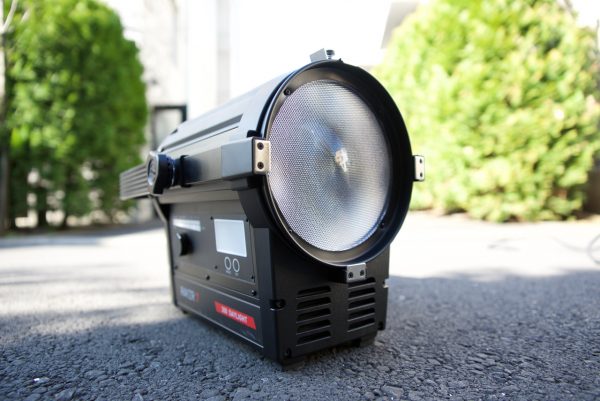
The light is claimed to be flicker free up to 15,000fps, but I’ll have to take their word for it as I don’t have access to a camera that can get anywhere need that sort of fps. I did, however, test the light at 200fps and it had no problems with any type of flicker.
Above you can see some very simple examples of how you can use a light like this to create a variety of results. This was done just using the Rayzr 7 to show how you can illuminate a subject or room in a “run and gun” news or documentary situation where you don’t have much time. Ideally I would probably be using more than one light, but for the purposes of this review I wanted to show what can be done with just the Rayzr 7. All these set ups can be achieved in under a minute once you have your light on a stand and powered up.
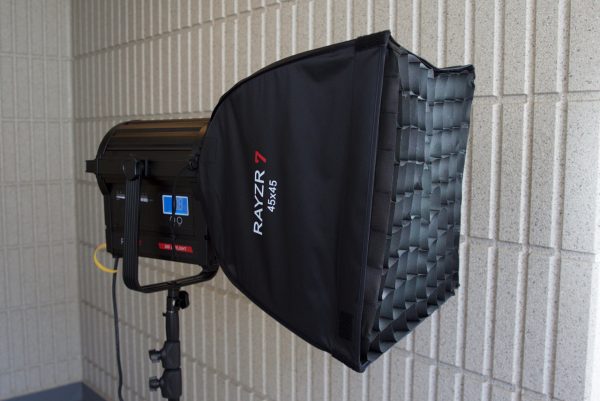
The 300 Daylight is available with or without barn doors and there is an optional softbox available that attaches to the light via an adapter ring. I really liked the design of the softbox and it is very quick and easy to attach to the light. It comes with two diffusion sheets and an egg crate which is also nice. Adding the softbox really makes the Daylight 300 a very versatile light as you can create a nice soft source from a high output light. Other optional extras include a wifi module.
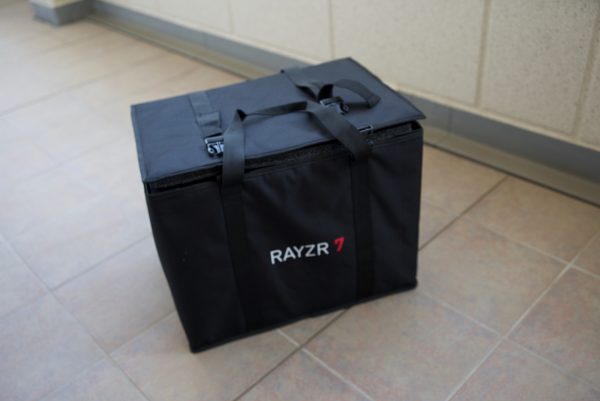
Another nice touch is that the light ships in its own custom soft/hard case which is a good thing, as finding a suitable bag for a light this size isn’t very easy. The case is robust enough that you could check it in on airplanes. If you are after a Bi-colour version Rayzr 7 also sells the 300B Bi-Colour, but it has only half the output of the 300 Daylight as it uses two 150W LED sources (one for tungsten and one for daylight).
As far as how the light performs out in the field, I found it to be a very useful addition to my lightning kit, although given its size it is not something I would carry around all the time. Despite it coming with a nice travel bag, for the the type of work I do I couldn’t see myself travelling with the light on overseas assignments. I did, however, find that the light was very handy when I was working around my local city.
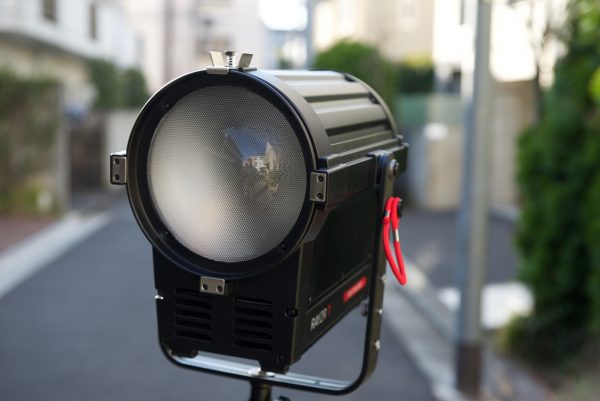
For those shooters who frequently have to use large HMI fresnel lights, the Daylight 300 makes a very compelling case for switching over to LED. It is extremely affordable given the output it produces, and it is very colour accurate from the testing I conducted. The addition of the optional softbox makes the Daylight 300 a much more versatile light. For lighting up large spaces and re creating the sun coming through a window you really can’t beat a large fresnel fixture. With the advances in LED technology it now certainly possible to get good results from much more power efficient and smaller sized lights.
The Rayzr 7 300 Daylight Standard Pack is available for €1269 (around $1339US) and the Premium Pack costs €1459 (around $1539US).
Lupo DayLed 2000 Daylight
I previously reviewed the DayLed 1000 last year and was impressed with its performance, price and portability. The newer DayLed 2000 Daylight is essentially its big brother, yet it still maintains the same design features.
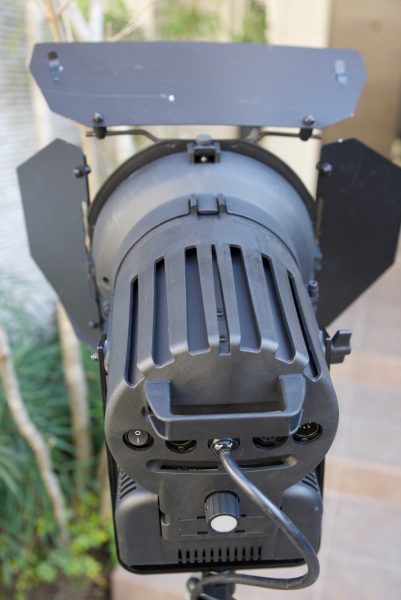
Like the DayLed 1000, the 2000 is made out of the same carbon fibre reinforced polymer that keeps the weight down to 4.8kg (10.58lb). The light feels very solidly made and my overall impression is that the build quality is slightly better than that of the Rayzr 7.
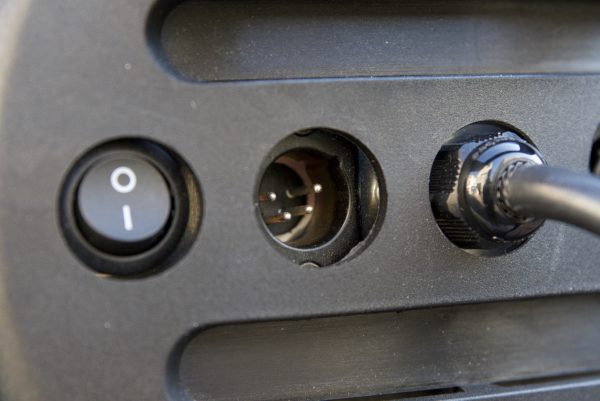
The light has a recessed on/off switch, a small knob for adjusting the light from its fully-flooded to fully-spotted position, DMX ports and a 4-pin power input for running the light off a compatible DC battery source. One thing to note-and it is a small thing-is that the Lupo has a built-in power cord unlike the Rayzr 7. This power cord is also longer by about 1 meter (3.28ft), which makes it easier to use without having to rely on an extension cord.
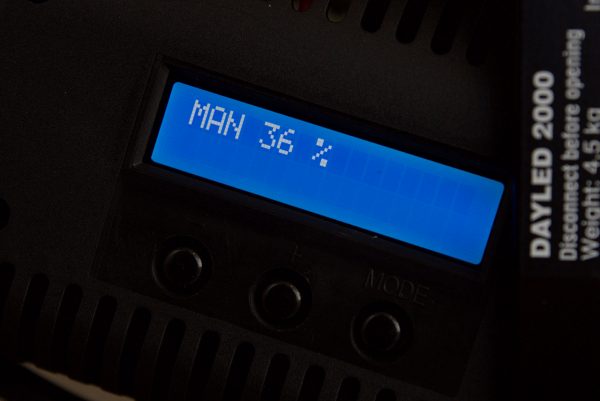
Just like the Rayzr 7 the light has an LED display panel on the side, although the Lupo’s is considerable smaller. Below the LED display are three buttons- one switches the light between regular and DMX control, and the other two increase or decrease the light’s output. Unlike the Rayzr 7 you can only make adjustments in 1% increments, but that does mean you can go from 0 to 100% in a lot shorter time. The other nice thing is that the LED display turns off when you are not using it. This may be a small thing, but for some shoots you may not want any additional extraneous light to be seen.
The light can be dimmed all the way down to 1% and it still stays on. Just like the Rayzr 7 you can turn the light off and when you turn it back on it remembers the output level you last had it set on. Unlike the Rayzr 7 there are no indicators on the light itself as to what beam angle the light is set to.

The light’s 200mm fresnel lens is well made and feels a lot more durable than that of the Rayzr 7. The light has a beam angle of 15° to 55° which is slightly wider than that of the Rayzr 7.
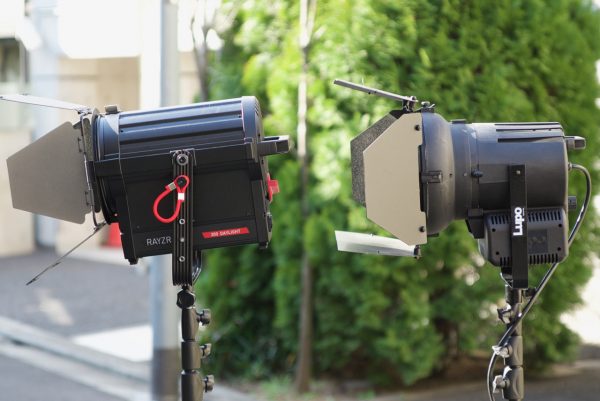
Like the Rayzr 7 the DayLed 2000 has an in-built fan. The noise level is a little lower than Rayzr 7 and it shouldn’t be a concern in most shooting situations. The light also does a very good job at dissipating any heat that gets produced and you can easily handle the light even after it has been on for long periods of time.
The Lupo is flicker free, although the company doesn’t list a maximum fps.
The DayLed 2000 can be run off 90-240V 50/60Hz AC power or from a 28V DC power source. The power draw is 220W, which allows the light to be powered off two camera batteries via a DC power adapter as long as both of the batteries can supply the combined wattage required.
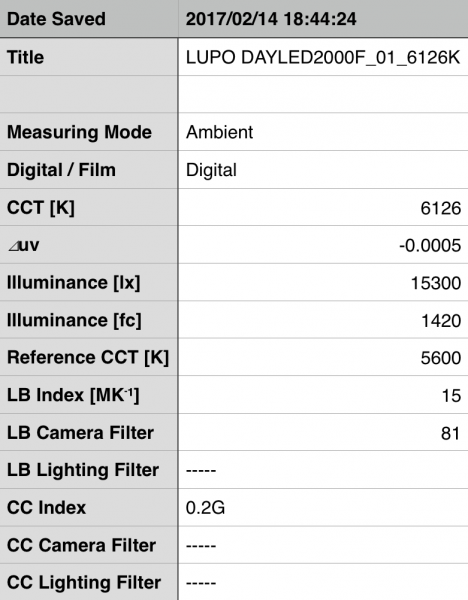
I measured the lights photometrics with a Sekonic C-700 placed at a distance of 1 meter (3.28ft) in a controlled environment. In its fully flooded position the DayLed 2000 recorded 15300lx at a distance of 1 meter. It had a kelvin temperature of 6126k, and a ⊿uv reading of -0.0005. It was no surprise that the DayLed 2000 recorded a lower output (15300lx) compared to that of the Rayzr 7 300 (25700lx). Comparing the output of the two is far from a fair fight, as you can’t compare apples to oranges. The Rayzr 7 has a 331W Nominal and 352W Maximum power draw while the DayLed 2000 is only 220W. The output of the Lupo was still impressive given its smaller size and power draw.
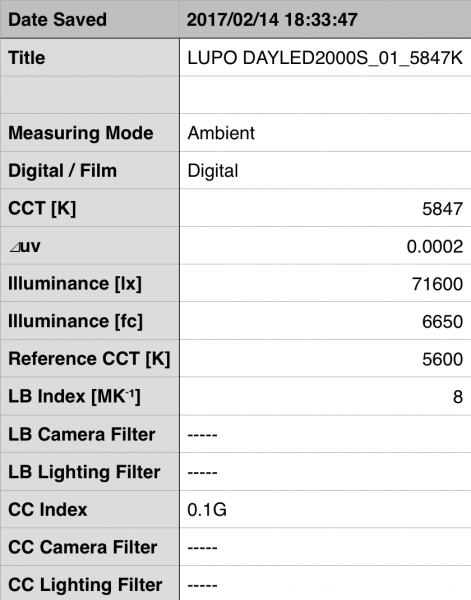
I then tested the light again in its full spot position and above you can see the output results. At a distance of 1 meter the light recorded 71600lx and a kelvin temperature of 58473k. The ⊿uv reading was 0.0002. The light is certainly capable of producing an extremely bright source when spotted up given its size and power draw. The light’s colour temperature accuracy in the spot position was slightly better at replicating a 5600k source than when it was in the flood position. In the full spot position the Rayzr 7 produces just over 4.12x the amount of output than when it is fully flooded. The Lupo DayLed 2000 produces 4.67x the amount of output than when it is fully flooded.
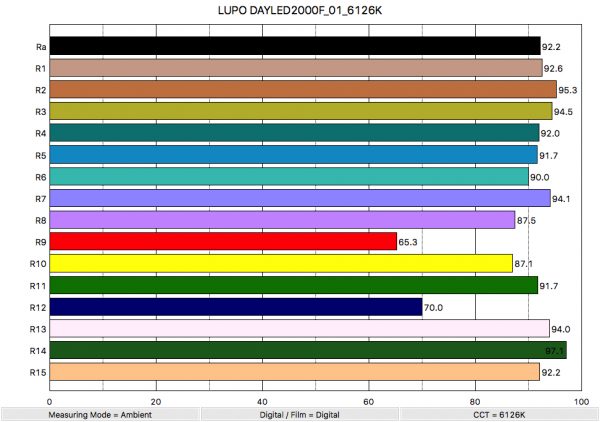
Above you can see the lights colour rendering scores when it was set in the flood position. The light recorded an average CRI (R1-R8) of 92.2 and an extended CRI (R1-R15) of 89.00. For the all important scores for replicating accurate skin tones, it recorded 65.3 for R9 (red), 94.0 for R13 (closest to caucasian skin tones), and 92.2 for R15 (closest to asian skin tones). These results weren’t quite as good as the figures recorded from the Rayzr 7, but none the less they were still pretty impressive.
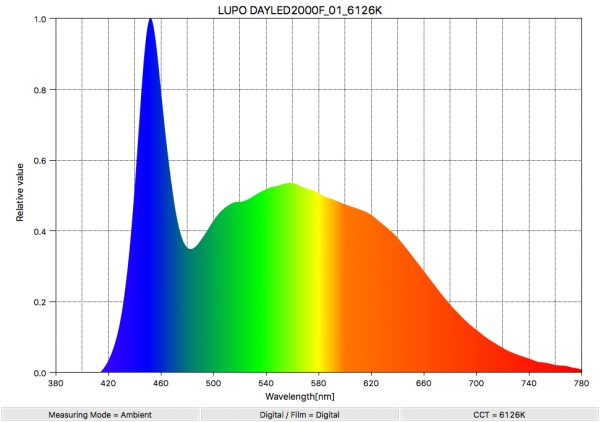
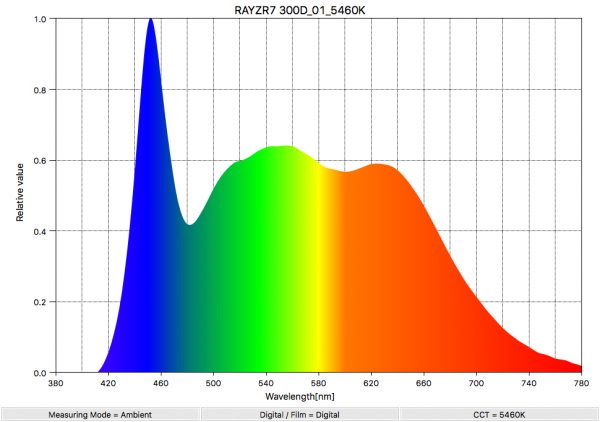
Where the DayLed 2000 was considerably worse was when it came to replicating R9 (red) where it only scored a 65.3 as opposed to the Rayzr 7’s 90.6. Above you can se the spectral distribution of the two lights. This result however, probably only equates to a very small real world difference if you were to compare the two lights side by side. If a light is missing a considerable amount of red in its spectral distribution but you white balance for a light that doesn’t have that problem you are going to see a colour shift on the light you are not balancing for. This is why people often complain about certain LED lights displaying a colour cast. This is usually because people are mixing lights from different manufacturers that have different colour rendering properties. This can usually be fixed in post fairly easily, but if you are turning around material quickly that won’t be touched it can potentially be a problem.
DP Scott Leslie tested the Lupo DayLed 2000 head-to-head against the Arri Tungsten 2K, and here are his thoughts:
Although they are different colour balances (the Arri is tungsten balanced and the Lupo is daylight balanced), I wanted to see if the Lupo was really putting out a 2K amount of light. What I discovered is the lights are very close to having the same output. The Arri was a little brighter but by less than half a stop. I also found that the quality of light was very similar between both fixtures. The benefits of LEDs over a tungsten hot light are numerous. First the Lupo DayLED 2000 only got slightly hot, nowhere near enough to burn you or put out any substantial heat. However the Arri 2K gets cookin’ hot and will burn your skin if not handled correctly. It’s also like a heater and will warm up the room and possibly overheat your actors/talent. Secondly, the Arri 2K takes a considerable amount of power. It will plug into a standard edison plug but you need to have it on it’s own 20 amp circuit or you’ll pop a breaker.
The Lupo 2k power consumption is very low and it can also run on a 28V battery. Lastly, the Lupo is completely dimmable and like most LEDs, the color does not shift when dimmed. The Arri isn’t dimmable and if you hook it up to a dimmer the color will shift warmer when dimmed. Both lights have almost identical spot and flood coverage.
As far as build quality, the Arri is built like a tank and has the weight to back it up. There is a reason why I’m still using this light 20 years later – it’s built to last! The Lupo is a hard plastic that seems to be very durable. On their site they say, “the lamp housing is made from carbon fibre reinforced polymer and is built to last a lifetime”. I’m not sure how they’ll stand up to the 20 year test but they do seem to be pretty solid. The Arri 2k is about 8lbs (3.6kg) heavier than the Lupo DayLED 2000.
A final item of note is that there is no place to puts scrims in the Lupo 2K. At first I thought this was a big deal but then I realized that the whole purpose of scrims are to decrease the output of the light which can be much more efficiently done through the dimmer.
Above is a short video I shot and edited for Deconstructive Media featuring my amazing niece Jill Stafford. This was a really fun shoot where we lit with only three Lupo LED lights:
1) Lupo DayLED 2000 fresnel – which was my primary backlight/kicker
2) Lupo DayLED 1000 fresnel – which was used as a backlight in the larger shots and squeezed down key in some shots.
3) Lupo Superpanel – I dimmed this down to about 20% and used it just for the background.
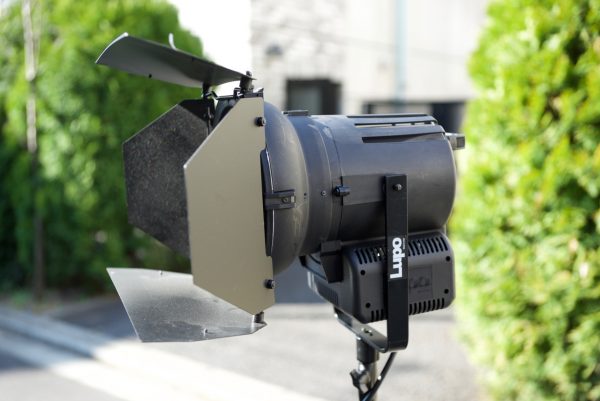
The DayLed 2000 ships with barn doors, but it doesn’t come with a custom case like the Rayzr 7. This is something to keep in mind, as large LED fresnel lights are not the easiest items to find a suitable bag for transporting and travelling with.
Optional items available for the Lupo include a DMX console, light stand and batteries. Unlike the Rayzr 7 there is no soft box available, but I am sure there is probably a solution out there on the market from a third party that would work. Lupo don’t make a Bi-colour version of the DayLed 2000, but it can be purchased in either tungsten or daylight.
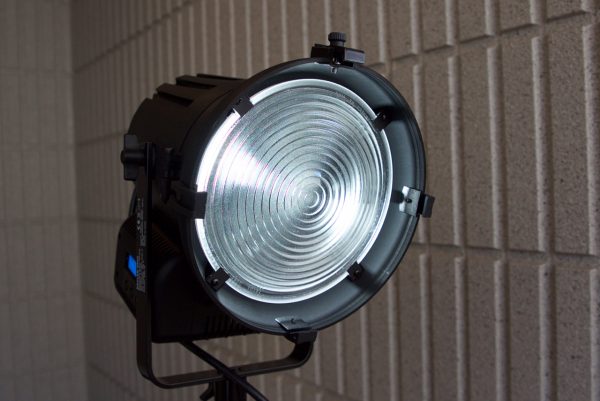
The DayLed 2000 is a really nice solution if you need a portable HMI LED replacement. While it doesn’t have the output of the larger and heavier Rayzr 7 Daylight 300 it is probably the better option if you are a shooter who travels a lot. It is well made and robust and despite having slightly lower colour rendering scores than the Rayzr 7 it still performs well.
In the UK the Lupo costs £1,120.00 ex VAT. In the US you can purchase Lupo lights from brightline. Brightline sells the DayLed 2000 for $1585US and that includes free shipping.
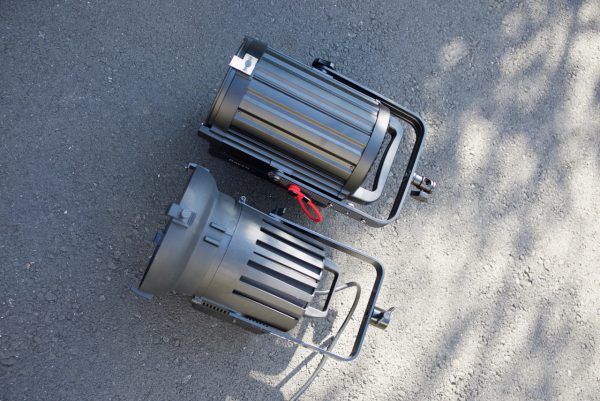
The Rayzr 7 Daylight 300 and Lupo DayLed 2000 Daylight are good alternatives if you are looking for an LED replacement for a HMI fresnel. Both are affordably priced and both provide a nice level of output. It’s not that one is better than the other, as both lights have their strengths and weaknesses. Which light is a better choice will entirely depend on what type of shooting or work you do. If size and weight isn’t a concern and you are after maximum output then the Rayzr 7 makes the most sense. If you travel a lot and need a more compact and lightweight solution then the Lupo is probably a better choice.
While neither the Rayzr 7 or Lupo has the advanced feature set and rugged construction of lights like the Arri L10-C, they are both considerably lighter and much more affordable. For owner/operators looking for a high output, lightweight, colour accurate LED fresnel fixture they are hard to beat.



